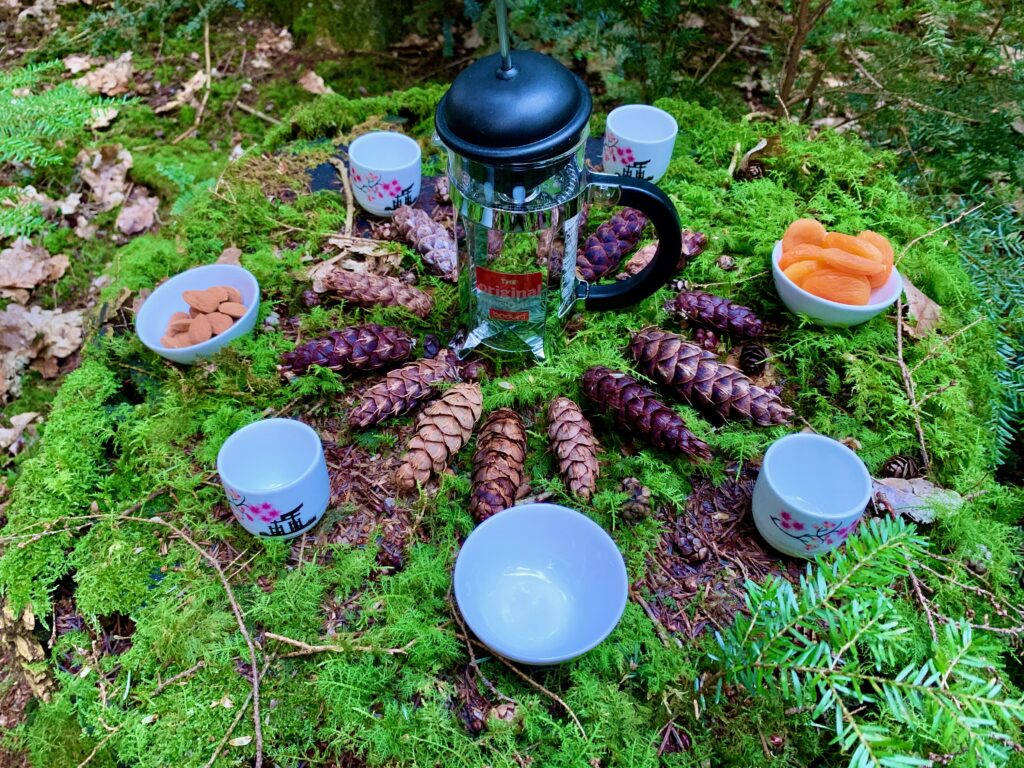What Is pine needle tea?
Pine needle tea is a refreshing herbal tea that if consumed regularly, is said to support better health. The tea is almost colourless and has a mildly citrusy aroma with minty undertones.
It’s made by steeping the needles of pine trees in hot water. You can buy pine needle tea online or in shops however you can also make it from scratch with foraged pine needles that you’ve collected yourself. Sounds fun, right?
A Japanese-inspired tea ceremony with pine needle tea is something I often include at the end of guided Forest Bathing events in Hampshire.
Read more about Forest Bathing here.
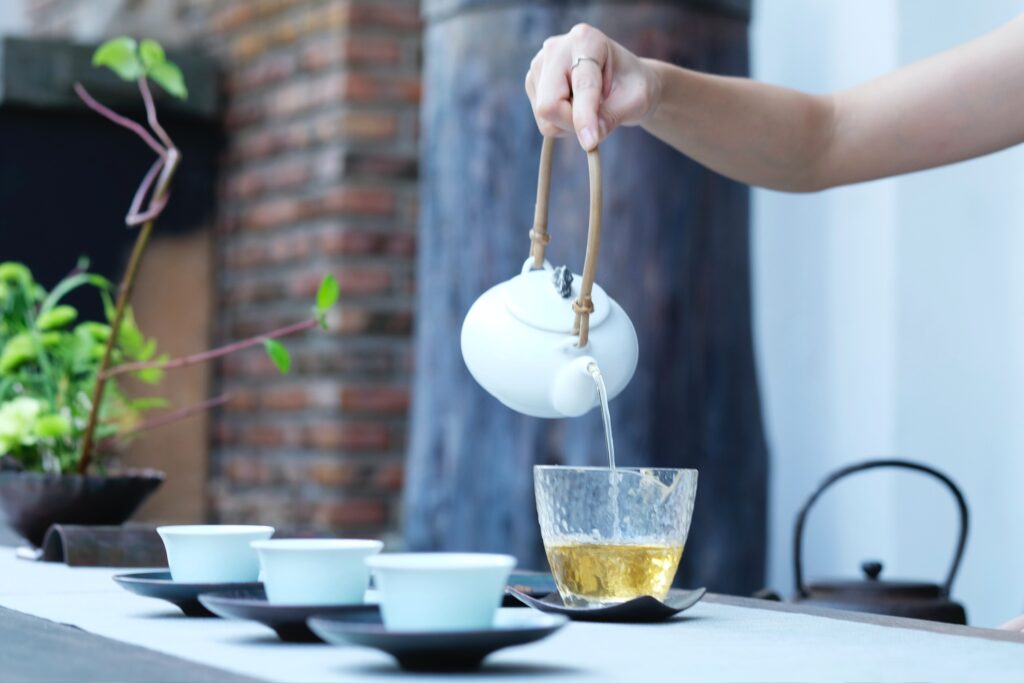
History of pine needle tea
Native Americans
Historically, the Native Americans, particularly the Haudenosaunee (Iroquois), considered white pine trees the “Tree of Peace.” They drank pine needle tea for centuries to both prevent illness and treat coughs and colds and later introduced the herbal tea to European settlers. It was consumed then as a way to combat scurvy, a centuries-old deadly disease caused by Vitamin C deficiency.
Taoism
I really love the references here to the Taoist priest, Wu Boli (late 14th – early 15th century), who painted an ancient pine tree. In the drawing, pine trees are buffeted by the elements, yet respond with the suppleness of their branches in order to survive. Their mixture of rigidity and flexibility allows them to live long lives, adjusting themselves to each season.
So, in order to strengthen their bodies, Taoists consumed pine needles, cones and resin.

Correctly identifying pines safe for making pine needle tea
Conifers are plants that bear cones and needle-like leaves. Many of the conifers with which we are most familiar are in the pine family (Pinaceae). This includes cedars, firs, hemlocks, larches, pines and spruces. The family is included in the order Pinales, formerly known as Coniferales.
Note – the toxic common yew tree (Taxus baccata in the family Taxaceae) looks similar to pine. Because it is one of three coniferous species native to and found widely across the UK, for the removal of doubt, do not make tea with yew due to its toxicity. Furthermore, I have also found claims that the following can cause digestive distress or worse. I haven’t spent ages investigating these claims myself, but please steer clear just in case:
- Ponderosa Pine (also known as Blackjack, Western Yellow, Yellow and Bull Pine)
- Lodgepole or Shore Pine
- Monterey Cypress and Monterey Pine
- Yew Pine
- Norfolk Island Pine
- Australian Pine
- Balsam Fir
I recommend that you only make tea with spruce, fir and pines not listed above, so it’s important to know how to correctly identify them. Read more here.
Fir tree key features
- Needles are short, soft, flat, are distributed around the stem and have a rounded edge
- The needles are flat so don’t easily roll in your fingers
- They connect to the stem by suction cup-like attachments
- The underside of the needle will have two white strips with a green line at the centre
- When crushed will smell strongly resinous/citrusy
- Fir Cones upright like candle flames
- Can be confused for toxic Yew but yew doesn’t have the citrusy smell in its needles. Yew needles are green underneath and do not carry the hallmark white lines like Fir needles
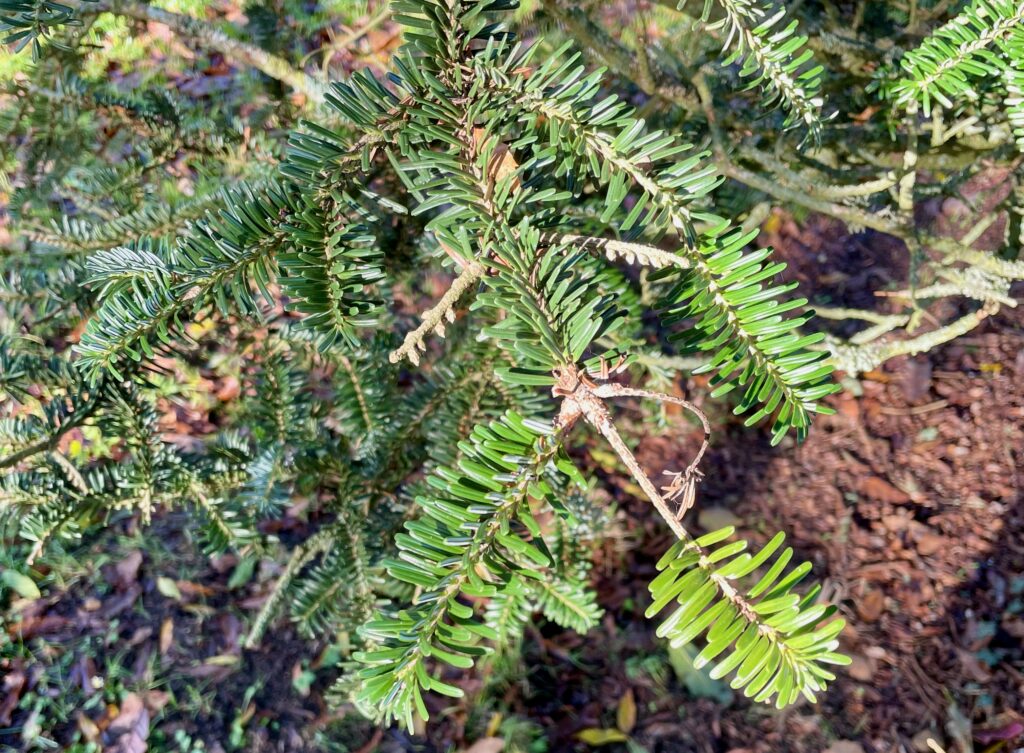
Spruce tree key features
- Branches less densely packed than Fir
- Needles are short, 4 sided with a pointed, sharp edge
- Needles are connected to the stem by a woody attachment
- Cones of Spruce are long and hang down from the tree
- Cone scales are smooth and overlapping, flexible and soft and smaller in size than Pine

Pine tree key features
- Needles are long, and pointed, and between two to five needles grow together in a little bundle (called a fascicle). This bundle is the easiest way to identify a pine
- Each fascicle has a little papery sheath at the base.
- Pinecones are hard and woody
- Clusters of male cones produce vast amounts of pollen on lower branches in spring.
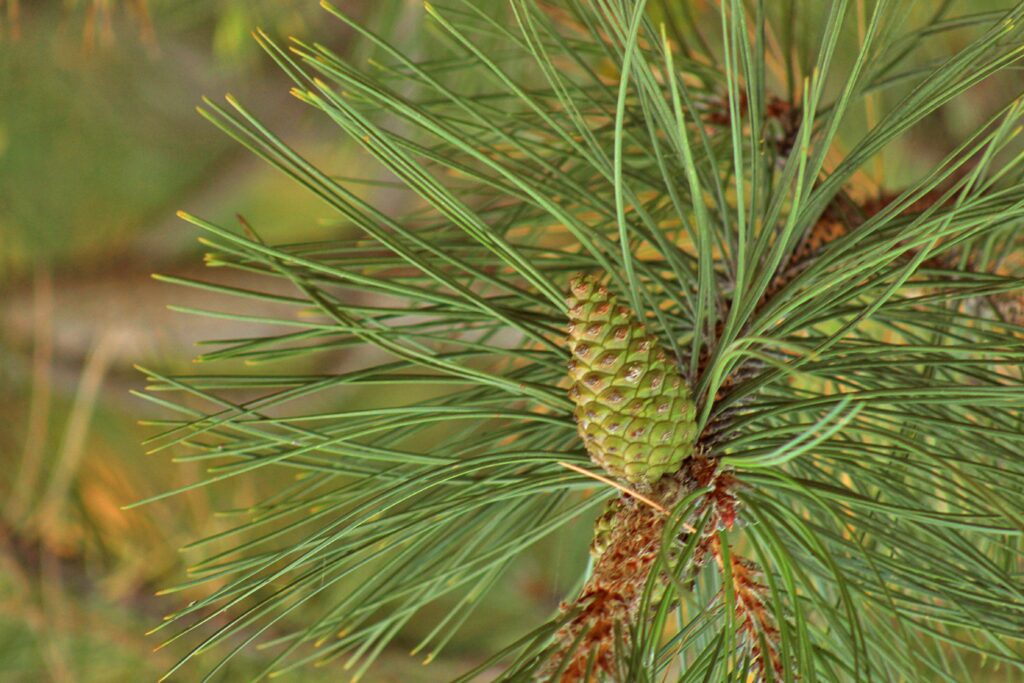
Benefits of drinking pine needle tea
Conifers and pines contain many organic, aromatic compounds (essential oils) known as terpenes as well as vitamins, minerals and antioxidants. Among these are Alpha-Pinene, Beta-Pinene, Beta-Phellandrene, D-Limonene and Vitamin A and C.
That’s an impressive list but what does it actually mean?
Well, a pine tree’s needles contain more Vitamin C (ascorbic acid) than fresh orange juice. In fact, the needles contain 5 times the concentration of vitamin C found in lemons. Vitamin C helps to protect against illness and infections and works as an antioxidant to combat free radicals in the body so could potentially reduce the risk of developing several chronic conditions from cardiovascular disease, type-2 diabetes and potentially, cancer.
Pine needle tea is also rich in Vitamin A, an antioxidant beta-carotene which helps improve vision, by maintaining a clear cornea, the outside covering of the eye. Vitamin A also supports hair and skin regeneration and red blood cell production.
Alpha and Beta-Pinene are anti-inflammatory and have decongestive and disinfectant effects on the respiratory system, often reducing and soothing throat irritation and inflamed bronchi.
Read more about the beneficial effects of the terpenes found in pine needles and therefore in pine needle tea, here.
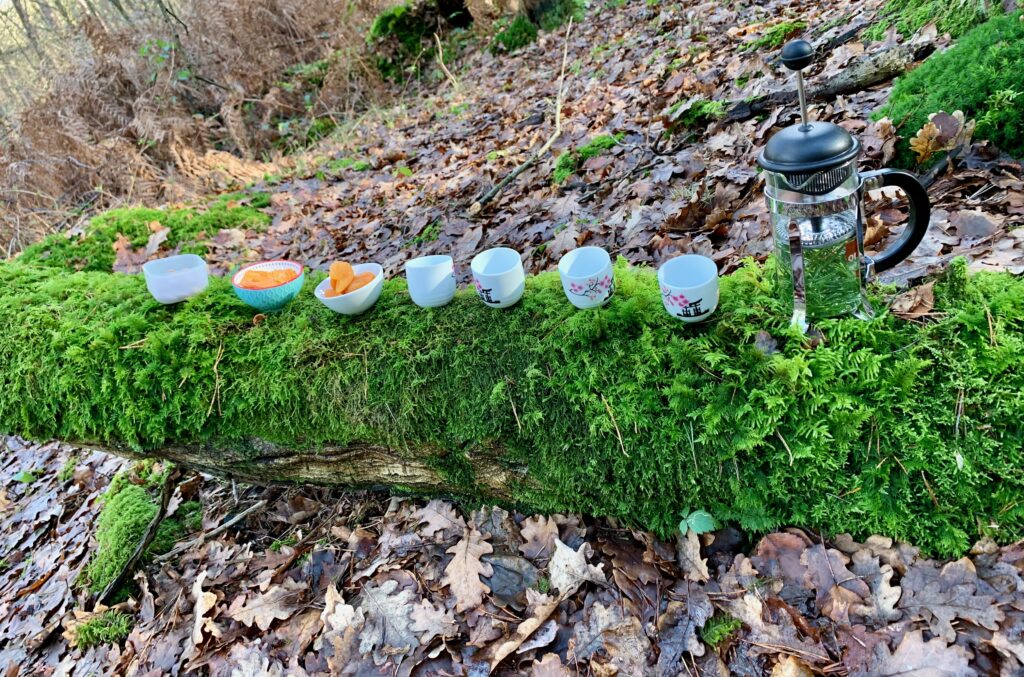
How to make pine needle tea
1. Choose your Trees
Older pine trees are more likely to survive after human intervention so don’t choose a very young tree. And choose a remote location far from cars or chemical treatments. It is better to take a little from several trees than to take the entire harvest from one.
2. Forage
Next, gather a handful of fresh, green needles from the end of a branch that’s high enough from the ground so that it won’t have been walked (or weed!) on.
3. Prepare
Remove the brown, papery sheath from the needles and wash them with water if you want. Chopping the needles into small pieces speeds up the release of the pine needle oils. Add them to a cup or better still, a cafetière.
4. Pour hot water onto the needles
Pour hot water over the needles and steep the tea for about 10 minutes. Cover the tea while steeping for the best results. Use a strainer before pouring if required.
5. Drink and enjoy your pine needle tea
Pine needle tea tastes great as-is, or you can add lemon, orange or spices as desired.
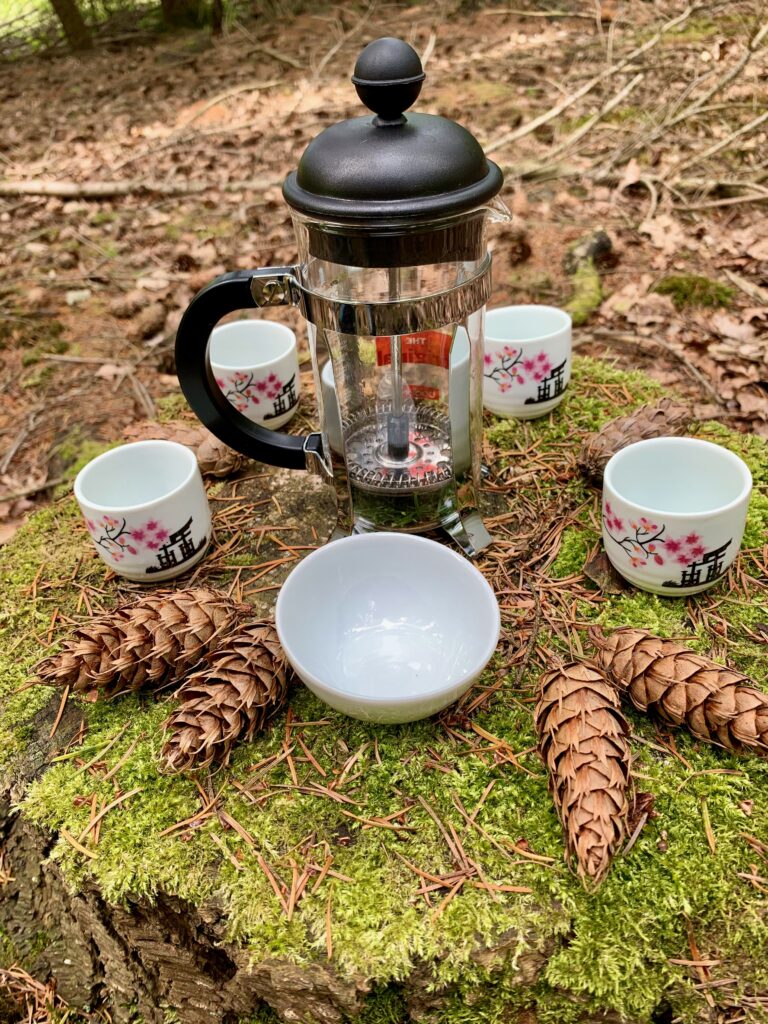
Ready, steady, go!
To benefit from the health improvements I’ve mentioned here you would need to drink pine needle tea regularly. And it’s also fair to say that although pine needle tea benefits the mind, body and soul in a plethora of ways, it isn’t a “fix-all” solution to your ailments. It goes without saying you should follow the advice of medical professionals.
The great thing is that if you want to, you can forage a nutritious cup of pine tea for free all year round. Will you be joining me soon?
And did you know there are many more reasons to love our pine and conifer trees? Read more here.
